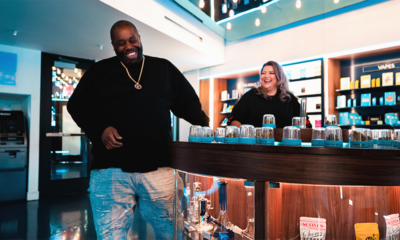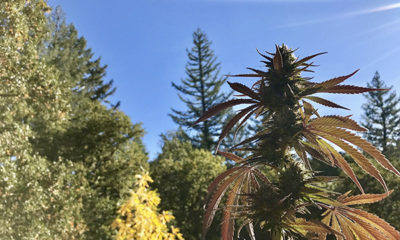
Joint Opinions
Industry Wars: Inside MJBizCon 2017
A cannabis businesswoman and journalist weighs in on the forces competing for control of the cannabis industry after the largest cannabis business conference in the world.
Stars whizzed by my head as I sat in the dark, transfixed by a screen the size of a football field taking me through a tour of galaxies beyond. I half expected C3PO to emerge and instruct me on how to properly fasten my seatbelt. “This is where it all happens,” a deep reverberating voice bellowed around me and thousands of other industry professionals, hypnotized by the flashing galactic imagery. While it felt like the start of Disneyland’s Star Tours, it was actually just the epic introduction to kick off this year’s MJBizCon in a newly-legal Las Vegas, Nevada.
In mid-November, I and 18,000 other industry professionals and investors descended on the Las Vegas Convention Center from all 50 states and 35 foreign countries for the 5th annual MJBizCon presented by MJBizDaily, the largest such gathering in the world. This year’s conference, the first of the Trump Era, perfectly highlighted the place the cannabis industry is in today; The Green Rush has reached a fever pitch and the scales have tipped away from social justice and towards the almighty dollar, even amid the chaos of the new administration. Everyone everywhere wants a piece of the almost-mostly-kinda legal pot, and the opposing forces of industry and movement are now shaping the commercial future together– whether they like it or not.
Time survived in the cannabis industry is measured in dog years, as the vast majority of its professionals have just emerged in the last few years since Colorado and Washington proved legal cannabis would be one of the largest growth industries in the nation. I consider myself both an old-timer (with my 10 human years converting to about 70 cannabis industry years) and a member of the business-minded world (as I have an MBA). For old-timers such as myself, the influx of suited investors that now outnumber the tie-dye clad activists feels a bit like what I imagine life would be like on Tatooine as the stormtroopers invaded: powerless. And to the business-minded world, the rebellious hippies and grungy stoners are an obstacle to overcome in order to appeal to a broader market and clean up this maligned plant’s image. In reality though, we patients, activists, investors and businesspeople need critical mass to survive, we need culture to keep us honest, and we need each other to fight the bigger foe: the feds.
At MJBizCon, my short-but-comparatively-long experience in the cannabis industry made it grating to hear a few industry folks declare they are the “firsts” at anything cannabis. In truth, the first came years before my time, and years before the time of my predecessors. Cannabis is not a device; none of us will invent it, patent it and be the main beneficiaries of its wealth, no matter how hard we try. In this industry, the money almost literally grows on trees. There is enough to go around for everyone if we do it right, but the money won’t start going round ‘til we fix what’s wrong.
What’s wrong? New regulations in states such as Ohio and Florida are supporting cannabis markets controlled by investors whose profits were derived from the unfair advantage of cannabis prohibition (in pharmaceuticals, alcohol, tobacco, fossil fuels, private prisons and law enforcement). The only way we can resist these cannabis “monopolies” is to work together.
And therein lies the rub: the investors and industry veterans who filled the halls of MJBizCon must combine forces.
We all benefit from living in a non-Orwellian world where facts actually matter, and the only way to move forward is to educate the public that they have been lied to and to tell the truth. But how do we move forward when we aren’t trying to understand each other? We must bridge the cultural divide, or simply the perception of it, as perfectly highlighted by MJBizCon keynote speaker George Blankenship.
Blankenship, an influential executive with an impressive track record at Tesla Motors, Apple Computers and The Gap stores, presented on the first day of MJBizCon, sharing some of his unique insights from his challenges there. Then, he flipped a slide and declared, “I don’t know your industry.”
He flipped to yet another slide, a black and white photo of the bare back of a long-haired hippie thigh deep in a pond that appeared next to a tie-dyed banner with the words “Summer of Love.” Blankenship went on to say that in his quick Google research to prepare for the presentation that he determined the industry’s greatest hurdle to overcome was the negative perception of cannabis, which he sourced straight to the hippie culture of the 1960s.
This comment caused me to slap my own palm to my forehead and think “No, no, no, no.” If anything, those naked hippies paved the way for the commercialization that brought Blankenship to the stage that day in the first place. There were even a few such hippies, hair slicked back into low ponytails rolling down the back of their suits, among us in the MJBizCon crowd. I believe that the image problem does not lie at the feet of the hippies, but again, with the feds.
Cannabis became illegal in the first place because of racist propaganda. The lies about immigrants smoking reefer justified a police state around this benign plant. Those same lies continue to justify the over-regulation that still hampers both cannabis consumption and the investment capital that many of the new industry folks are hoping to put into the industry. There are so many twists, turns, back stories and depths to the cannabis industry and legalization movement that without a long-view, however, it’s hard to properly see the whole picture.
And here is part of the bigger picture: Income inequality around the globe has been steadily increasing. The day I landed in Las Vegas for MJBizCon, I waded through a sea of slot machines at the airport while also reading an article on my cell phone about a Credit Suisse report making international headlines: “Richest 1% Now Owns Half the Wealth.”
As I arrived at the baggage claim and finished reading the article, I put my phone away and started hawkishly examining the bags popping out from Portland onto the conveyer belt. Some had little stickers or logos from their companies, the little five-bladed leaves the tell-tale sign of someone here for the same convention. I looked around the carousel and saw some people had little leaves on their hats, on the t-shirts poking out of their business-casual blazers or on the reusable bags they had hanging off their shoulders. As I leaned over to pick up my bag and missed, a man next to me scooped it up and plopped it in front of me. I noticed the leaf on his bag immediately and we struck up conversation as we both walked in the direction of the ride-share pickup area. He had just started a cannabis marketing company in the last year, and like the thousands of other people landing in Las Vegas that day, he was looking to this industry for long-term financial stability.
But we are all in for a bumpy ride. One of the most critical themes at MJBizCon this year was the price of pot. As California’s legal market goes online next year, a glut in the local supply (and other states getting into the legalization game first, including Nevada) has driven down the price of both outdoor and indoor cannabis, a sign that small farmers may have trouble surviving. Green Rushers have flooded in to capitalize on the collapsing of small businesses, but new investors don’t always understand cannabis and make mistakes when they try to shape it in the image of something they are more familiar with, like tobacco, alcohol, pharmaceuticals or a Wall Street hedge fund.
For large or small businesses to thrive in this new market, however, the onus is on the old-timers to teach the new money what’s up: Cannabis is not your typical agricultural commodity. It’s spiritual, medical, cultural and cultivation culture is best when shared by many farmers instead of just a few. If the legal market doesn’t look like that, it will thrive once again underground. If the big money wants to really establish a foothold, it shouldn’t simply invest in regulations to its own benefit, but also those that make the justice system and regulations more fair for us all and foster true economic competition. Funding real activism is the best marketing investment money can buy in the Orwellian world of cannabis law. May the force be with all you cannabis educators.
TELL US, did you go to MJBizCon this year?
























